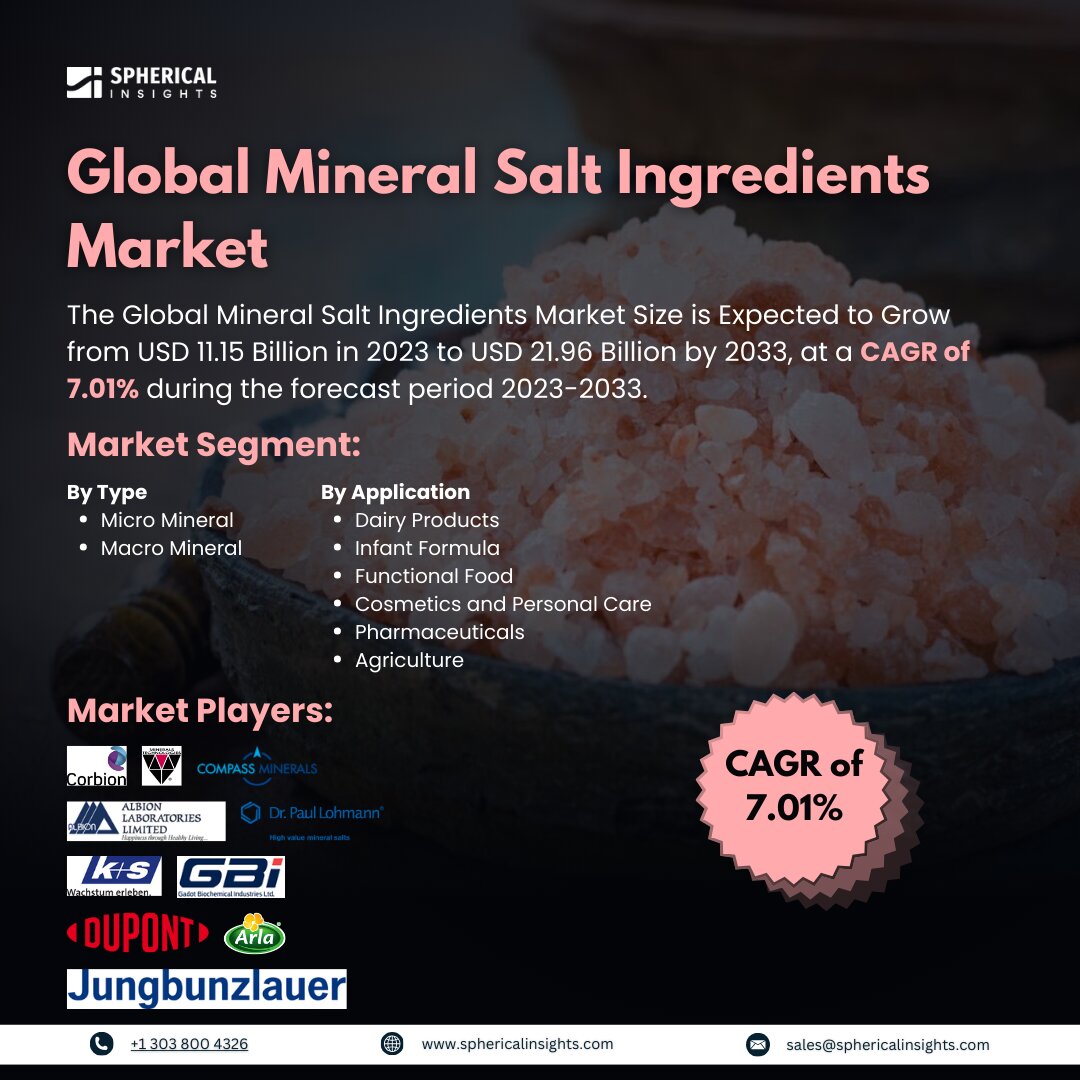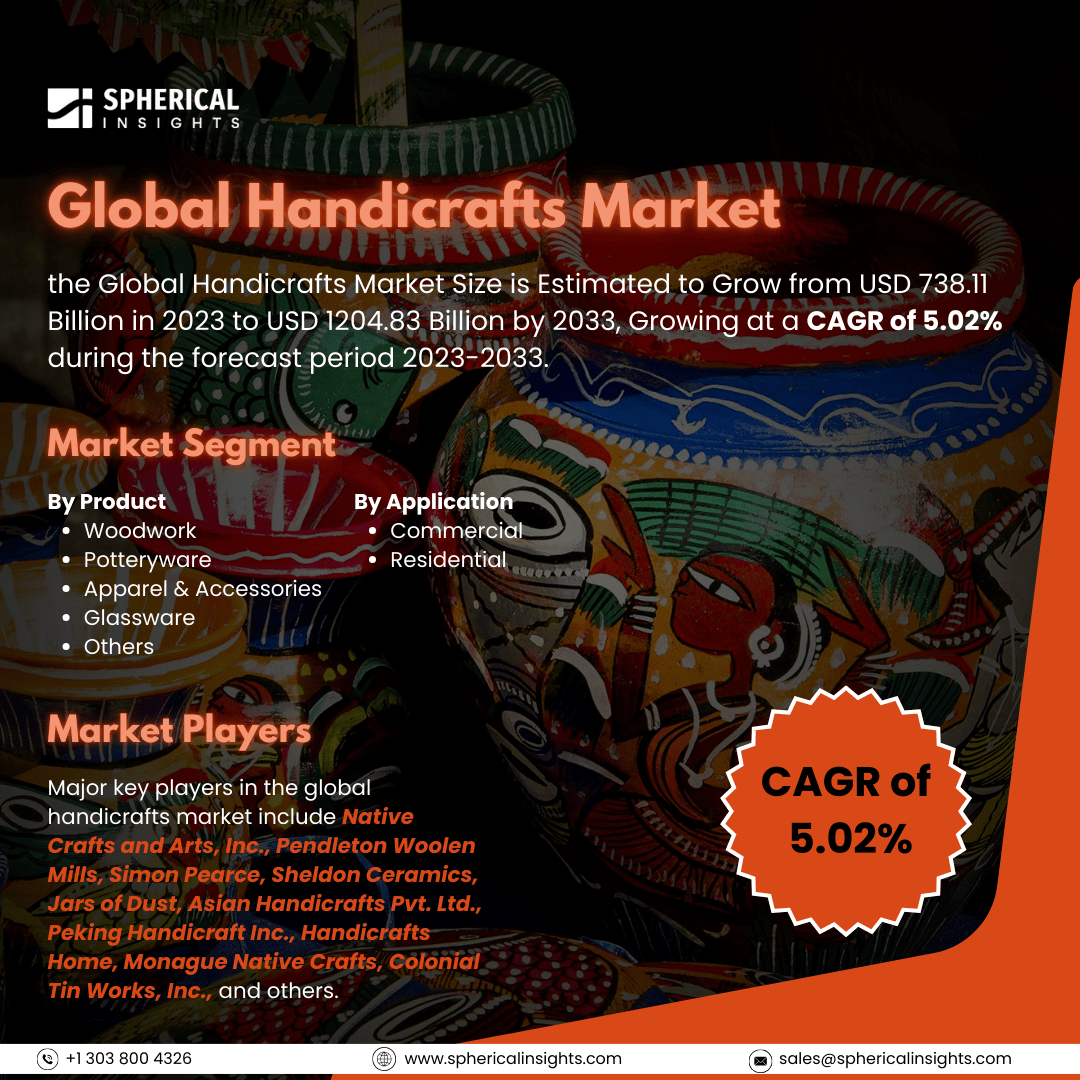Global Mineral Salt Ingredients Market Size to Exceed USD 21.96 Billion by 2033
According to a research report published by Spherical Insights & Consulting, the Global Mineral Salt Ingredients Market Size is Expected to Grow from USD 11.15 Billion in 2023 to USD 21.96 Billion by 2033, at a CAGR of 7.01% during the forecast period 2023-2033.
Browse 210 market data Tables and 45 Figures spread through 190 Pages and in-depth TOC on the Global Mineral Salt Ingredients Market Size, Share, and COVID-19 Impact Analysis, By Type (Micro Mineral and Macro Mineral), By Application (Dairy Products, Infant Formula, Functional Food, Cosmetics and Personal Care, Pharmaceuticals, and Agriculture), and By Region (North America, Europe, Asia-Pacific, Latin America, Middle East, and Africa), Analysis and Forecast 2023 – 2033
The market for mineral salt ingredients includes a broad variety of inorganic compounds derived from minerals that are widely utilized in various industries, including food and beverage, medicines, personal care, and agriculture. These ingredients are essential for enhancing the taste, consistency, and nutritional value of food products as well as their functional attributes, such as stability and preservation. Mineral salts, which can be produced artificially or obtained from natural mineral sources, offer a variety of essential nutrients required to maintain the physiological equilibrium of living organisms. Additionally, the market is anticipated to increase as a result of the expanding food industry and growing awareness of the health advantages of mineral salt. Growing instances of mineral and salt deficiencies, including sleeplessness, exhaustion, weakness, osteoporosis, anemia, melancholy, and goiter, are also anticipated to propel market expansion. Growing health-conscious customers worldwide as a result of increased wellness awareness is also anticipated to fuel market expansion. However, consumer mistrust and a negative image are caused by some manufacturers and suppliers false promises and misleading information about their products, which is predicted to limit market expansion.
The macro mineral segment held the highest share in 2023 and is anticipated to grow at a significant CAGR during the projected timeframe.
Based on type, the global mineral salt ingredients market is categorized as micro mineral and macro mineral. Among these, the macro mineral segment held the highest share in 2023 and is anticipated to grow at a significant CAGR during the projected timeframe. The market for mineral salt components has shown a high demand for a number of various mineral ions, such as magnesium, sodium, potassium, chloride, and phosphorus. When taken frequently with meals, two grams of sodium and five grams of magnesium salt offer a plethora of nutrients.
The functional food segment held the highest share in 2023 and is anticipated to grow at a significant CAGR during the projected timeframe.
Based on the application, the global mineral salt ingredients market is categorized as dairy products, infant formula, functional food, cosmetics and personal care, pharmaceuticals, and agriculture. Among these, the functional food segment held the highest share in 2023 and is anticipated to grow at a significant CAGR during the projected timeframe. Minerals for salt production in humans and animals are known to be present in functional dietary products. The rising need for calcium in manufacturing has led to the addition of more mineral ions to functional foods.
Asia-Pacific is projected to hold the largest share of the global mineral salt ingredients market over the forecast period.
Asia-Pacific is projected to hold the largest share of the global mineral salt ingredients market over the forecast period. The food industry has a larger customer base in this area. Mineral salt-containing foods have become more popular in the Asia-Pacific area. People's awareness of the value of health is growing rapidly. The quest for healthier cooking has led to a huge development in the market for mineral salt components. It is India and the Netherlands that consume the most mineral salt component products. To attract consumers, this product also comes in a variety of tastes in the agriculture industry.
North America is expected to grow at the fastest CAGR growth of the global mineral salt ingredients market during the forecast period. The agriculture industry, which produces products containing mineral salt as a component, has the biggest market in this region. The growing demand for soil-enriching products has led to a rise in sales of products that contain mineral salt components. Due to the widespread usage of agricultural products such as feed mix salt, stock salt, and simple salt blocks, the market is growing.
Competitive Analysis
Major vendors in the global mineral salt ingredients market are Corbion, Minerals Technologies Inc., Compass Minerals International Inc., Albion Laboratories, Inc., Dr. Paul Lohmann GmbH KG, K+S AKTIENGESELLSCHAFT, Gadot Biochemical Industries Ltd., Arla Foods amba, DuPont, Jungbunzlauer Suisse AG, and Others.
Key Target Audience
- Market Players
- Investors
- End-users
- Government Authorities
- Consulting and Research Firm
- Venture capitalists
- Value-Added Resellers (VARs)
Key Market Development
- In June 2022, monomagnesium citrate and zinc gluconate are two new mineral salts that Jungbunzlauer introduced. Through a procedure known as neutralization, gluconic acid, and a highly pure zinc source are combined to create zinc gluconate.
Market Segment
This study forecasts revenue at global, regional, and country levels from 2020 to 2033. Spherical Insights has segmented the global mineral salt ingredients market based on the below-mentioned segments:
Global Mineral Salt Ingredients Market, By Type
- Micro Mineral
- Macro Mineral
Global Mineral Salt Ingredients Market, By Application
- Dairy Products
- Infant Formula
- Functional Food
- Cosmetics and Personal Care
- Pharmaceuticals
- Agriculture
Global Mineral Salt Ingredients Market, By Regional
- North America
- Europe
- Germany
- UK
- France
- Italy
- Spain
- Russia
- Rest of Europe
- Asia Pacific
- China
- Japan
- India
- South Korea
- Australia
- Rest of Asia Pacific
- South America
- Brazil
- Argentina
- Rest of South America
- Middle East & Africa
- UAE
- Saudi Arabia
- Qatar
- South Africa
- Rest of the Middle East & Africa



